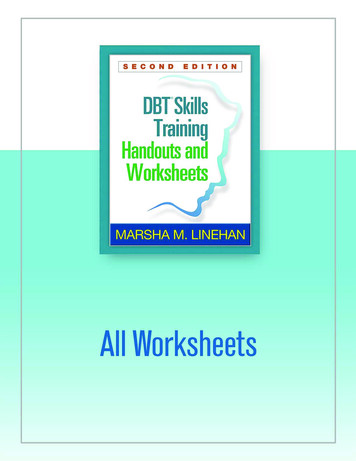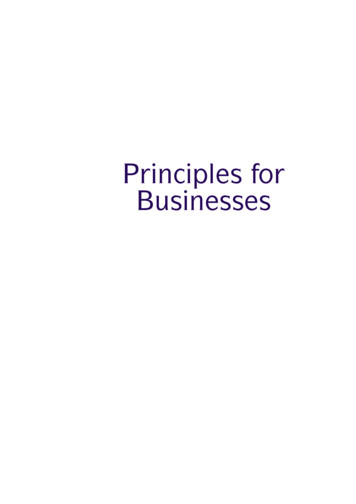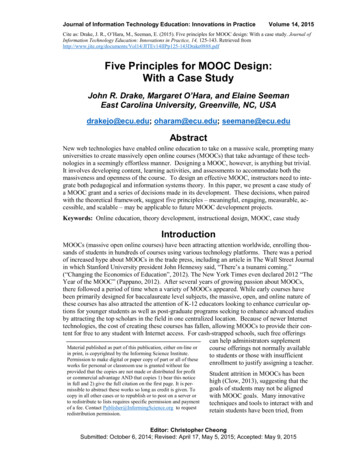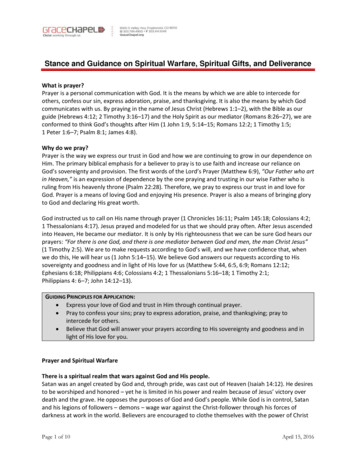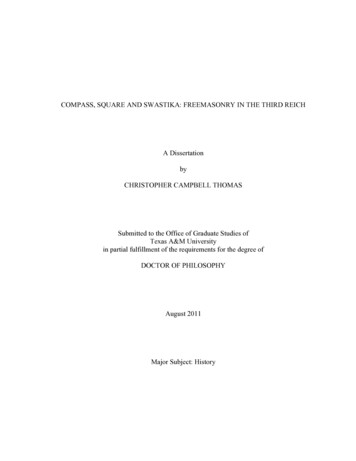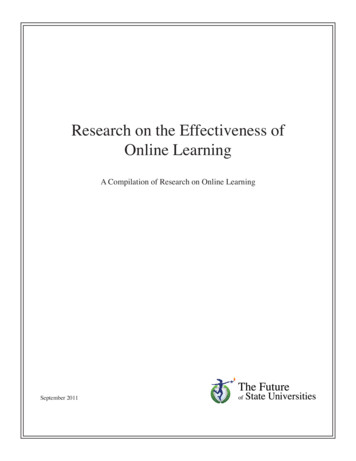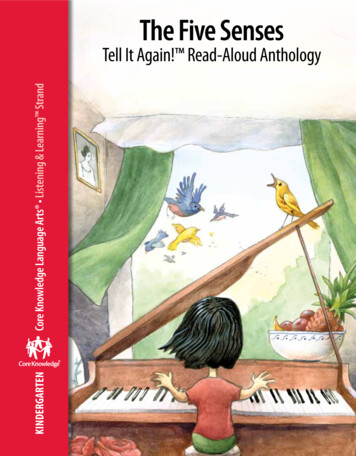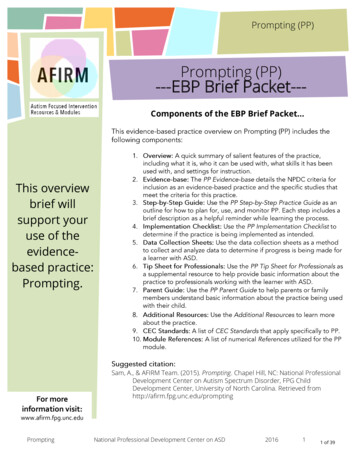
Transcription
Prompting (PP)Prompting (PP)---EBP Brief Packet--Components of the EBP Brief Packet This overviewbrief willsupport youruse of theevidencebased practice:Prompting.8.For moreinformation visit:Sam, A., & AFIRM Team. (2015). Prompting. Chapel Hill, NC: National ProfessionalDevelopment Center on Autism Spectrum Disorder, FPG ChildDevelopment Center, University of North Carolina. Retrieved g.unc.eduPromptingNational Professional Development Center on ASD201611 of 39
Prompting (PP)What is Prompting?Prompting includes any help given to a learner that assists the learner in using a specific skill orbehavior. Sometimes referred to as an errorless learning method, prompting reduces incorrectresponding as learners acquire new skills. Prompting is a foundational practice that is used withother evidence-based practices (such as, time delay and reinforcement) and as part of theprotocols for evidence-based practices (such as discrete trial training, pivotal response training,and video modeling).Evidence-baseBased upon the recent review, prompting meets the evidence-based practice criteria set byNPDC with 32 single case design studies. The practice has been effective for early intervention (02 years) to high school-age learners (15-22 years) with ASD. Evidence-based practices (EBP) andstudies included in the 2014 EBP report detailed how prompting can be used effectively toaddress: academic, adaptive, behavior, communication, joint attention, motor, play, schoolreadiness, social, and vocational outcomes.How is PP Being Used?Prompting can be used by a variety of professionals, including teachers, special educators,therapists, paraprofessionals, and early interventionists in educational and community-basedenvironments. Parents and family members also can use prompting in the home.For moreinformation visit:www.afirm.fpg.unc.eduPromptingNational Professional Development Center on ASD201622 of 39
Prompting (PP)---Evidence-base for Prompting--The National Professional Development Center on ASD has adopted the following criteria to determine if apractice is evidence-based. The EBP Report provides more information about the review process (Wong etal., 2014).Efficacy must be established through high quality, peer-reviewed research in scientific journals using: randomized or quasi-experimental design studies (two high quality experimental or quasiexperimental group design studies), single-subject design studies (three different investigators or research groups must haveconducted five high quality single subject design studies), or combination of evidence [one high quality randomized or quasi-experimental group design studyand three high quality single subject design studies conducted by at least three differentinvestigators or research groups (across the group and single subject design studies)].--OVERVIEW-Prompting is a foundational practice that includes any help given to learners with ASD to assist them in usinga specific skill. Prompting meets the evidence-based practice criteria with 32 single case design studies. Thepractice has been effective with learners in early intervention (0-2 years) to high school (15-22 years). Studiesincluded in the 2014 EBP report detailed how prompting can be used effectively to address: academic,adaptive, behavior, communication, joint attention, motor, play, school readiness, social, and vocationaloutcomes.In the table below, the outcomes identified by the evidence base are shown by age of participants.Early tionCommunicationJoint AttentionJoint cademicAcademicNational Professional Development Center on ASDAcademic20151 3 of 39
Prompting (PP)Early intervention (0-2 years)*Barton, E. E., & Wolery, M. (2010). Training teachers to promote pretend play in young children with disabilities.Exceptional Children, 77(1), 85-106.Preschool (3-5 years)*Barton, E. E., & Wolery, M. (2010). Training teachers to promote pretend play in young children with disabilities.Exceptional Children, 77(1), 85-106.Endicott, K., & Higbee, T. S. (2007). Contriving motivating operations to evoke mands for information in preschoolerswith autism. Research in Autism Spectrum Disorders, 1(3), 210-217. doi: 10.1016/rasd.2006.10.003Fischer, J. L., Howard, J. S., Sparkman, C. R., & Moore, A. G. (2010). Establishing generalized syntactical responding inyoung children with autism. Research in Autism Spectrum Disorders, 4(1), 76-88. doi: 10.1016/j.rasd.2009.07.009Groskreutz, N. C., Groskreutz, M. P., & Higbee, T. S. (2011). Effects of varied levels of treatment integrity on appropriatetoy manipulation in children with autism. Research in Autism Spectrum Disorders, 5(4), 1358-1369. doi:10.1016/j.rasd.2011.01.018Ingvarsson, E. T., & Hollobaugh, T. (2011). A comparison of prompting tactics to establish intraverbals in children withautism. Journal of Applied Behavior Analysis, 44(3), 659-664. doi: 10.1901/jaba.2011.44-659*Ingvarsson, E. T., & Le, D. D. (2011). Further evaluation of prompting tactics for establishing intraverbal responding inchildren with autism. The Analysis of Verbal Behavior, 27(1), 75.Koegel, R. L., Shirotova, L., & Koegel, L. K. (2009). Brief report: Using individualized orienting cues to facilitate first-wordacquisition in non-responders with autism. Journal of autism and developmental disorders, 39(11), 1587-1592.doi: 10.1007/s10803-009-0765-9Leaf, J. B., Sheldon, J. B., & Sherman, J. A. (2010). Comparison of simultaneous prompting and no‐no prompting in two‐choice discrimination learning with children with autism. Journal of Applied Behavior Analysis, 43(2), 215-228. doi:10.1901/jaba.2010.43-215Ostryn, C., & Wolfe, P. S. (2011). Teaching children with autism to ask “what's that?” using a picture communication withvocal results. Infants & Young Children, 24(2), 174-192. doi: 10.1097/IYC.0b013e31820d95ffReichle, J., Dropik, P. L., Alden-Anderson, E., & Haley, T. (2008). Teaching a young child with autism to request assistanceconditionally: A preliminary study. American Journal of Speech-Language Pathology, 17(3), 231. doi: 10.1044/10580360(2008/022)*Tarbox, J., Zuckerman, C. K., Bishop, M. R., Olive, M. L., & O'Hora, D. P. (2011). Rule-governed behavior: Teaching apreliminary repertoire of rule-following to children with autism. The Analysis of verbal behavior, 27(1), 125.Taylor, B. A., & Hoch, H. (2008). Teaching children with autism to respond to and initiate bids for joint attention. Journalof Applied Behavior Analysis, 41(3), 377-391. doi: 10.1901/jaba.2008.41-377PromptingNational Professional Development Center on ASD20152 4 of 39
Prompting (PP)Preschool (3-5 years continued)Thomas, B. R., Lafasakis, M., & Sturmey, P. (2010). The effects of prompting, fading, and differential reinforcement onvocal mands in non‐verbal preschool children with autism spectrum disorders. Behavioral Interventions, 25(2),157-168. doi: 10.1002/bin.300Twarek, M., Cihon, T., & Eshleman, J. (2010). The effects of fluent levels of Big 6 6 skill elements on functional motorskills with children with autism. Behavioral Interventions, 25(4), 275-293. doi: 10.1002/bin.317Vedora, J., Meunier, L., & Mackay, H. (2009). Teaching intraverbal behavior to children with autism: A comparison oftextual and echoic prompts. The Analysis of Verbal Behavior, 25(1), 79.Williams, G., Donley, C. R., & Keller, J. W. (2000). Teaching children with autism to ask questions about hidden objects.Journal of Applied Behavior Analysis, 33(4), 627-630. doi: 10.1901/jaba.2000.33-627Elementary (6-11 years)*Akmanoglu, N., & Batu, S. (2004). Teaching pointing to numerals to individuals with autism using simultaneousprompting. Education and Training in Developmental Disabilities, 39(4), 326-336.Anderson, J., & Le, D. D. (2011). Abatement of intractable vocal stereotypy using an overcorrection procedure.Behavioral Interventions, 26(2), 134-146. doi: 10.1002/bin.326Birkan, B., McClannahan, L. E., & Krantz, P. J. (2007). Effects of superimposition and background fading on the sightword reading of a boy with autism. Research in Autism Spectrum Disorders, 1(2), 117-125. doi:10.1016/j.rasd.2006.08.003Coe, D., Matson, J., Fee, V., Manikam, R., & Linarello, C. (1990). Training nonverbal and verbal play skills to mentallyretarded and autistic children. Journal of Autism and Developmental Disorders, 20(2), 177-187. doi:10.1007/BF02284717*Ingvarsson, E. T., & Le, D. D. (2011). Further evaluation of prompting tactics for establishing intraverbal responding inchildren with autism. The Analysis of Verbal Behavior, 27(1), 75.Shabani, D. B., Katz, R. C., Wilder, D. A., Beauchamp, K., Taylor, C. R., & Fischer, K. J. (2002). Increasing social initiations inchildren with autism: Effects of a tactile prompt. Journal of Applied Behavior Analysis, 35(1), 79-83. doi:10.1901/jaba.2002.35-79Shillingsburg, M. A., Valentino, A. L., Bowen, C. N., Bradley, D., & Zavatkay, D. (2011). Teaching children with autism torequest information. Research in Autism Spectrum Disorders, 5(1), 670-679. doi: 10.1016/j.rasd.2010.08.004*Tarbox, J., Zuckerman, C. K., Bishop, M. R., Olive, M. L., & O'Hora, D. P. (2011). Rule-governed behavior: Teaching apreliminary repertoire of rule-following to children with autism. The Analysis of verbal behavior, 27(1), 125.Whalon, K., & Hanline, M. F. (2008). Effects of a reciprocal questioning intervention on the question generation andresponding of children with autism spectrum disorder. Education and Training in Developmental Disabilities,43(3), 367.PromptingNational Professional Development Center on ASD20153 5 of 39
Prompting (PP)Elementary (6-11 years continued)Yanardag, M., Birkan, B., Yılmaz, İ., Konukman, F. K., Ağbuğa, B., & Lieberman, L. (2011). The effects of least-to-mostprompting procedure in teaching basic tennis skills to children with autism. Kineziologija, 43(1), 44-55.Yi, J. I., Christian, L., Vittimberga, G., & Lowenkron, B. (2006). Generalized negatively reinforced manding in children withautism. The Analysis of Verbal Behavior, 22(1), 21.Yılmaz, I., Konukman, F., Birkan, B., & Yanardag, M. (2010). Effects of most to least prompting on teaching simpleprogression swimming skill for children with autism. Education and Training in Autism and DevelopmentalDisabilities, 440.Middle (12-14 years)*Akmanoglu, N., & Batu, S. (2004). Teaching pointing to numerals to individuals with autism using simultaneousprompting. Education and Training in Developmental Disabilities, 39(4), 326-336.Batchelder, A., McLaughlin, T. F., Weber, K. P., Derby, K. M., & Gow, T. (2009). The effects of hand-over-hand and a dotto-dot tracing procedure on teaching an autistic student to write his name. Journal of Developmental andPhysical Disabilities, 21(2), 131-138. doi: 10.1007/s10882-009-9131-2Harris, S. L., Handleman, J. S., & Alessandri, M. (1990). Teaching youths with autism to offer assistance. Journal of AppliedBehavior Analysis, 23(3), 297-305. doi: 10.1901/jaba.1990.23-297High (15-22 years)Akmanoglu, N., & Batu, S. (2004). Teaching pointing to numerals to individuals with autism using simultaneousprompting. Education and Training in Developmental Disabilities, 39(4), 326-336.Bouxsein, K. J., Tiger, J. H., & Fisher, W. W. (2008). A comparison of general and specific instructions to promote taskengagement and completion by a young man with Asperger syndrome. Journal of Applied Behavior Analysis,41(1), 113-116. doi: 10.1901/jaba.2008.41-113Cihak, D. F., & Grim, J. (2008). Teaching students with autism spectrum disorder and moderate intellectual disabilities touse counting-on strategies to enhance independent purchasing skills. Research in Autism Spectrum Disorders,2(4), 716-727.Montgomery, J., Storey, K., Post, M., & Lemley, J. (2011). The use of auditory prompting systems for increasingindependent performance of students with autism in employment training. International Journal of RehabilitationResearch, 34(4), 330-335. doi: 10.1097/MRR.0b013e32834a8fa8Symons, F., & Davis, M. (1994). Instructional conditions and stereotyped behavior: The function of prompts. Journal ofBehavior Therapy and Experimental Psychiatry, 25(4), 317-324. doi: 10.1016/0005-7916(94)90040-X* Research which included participants in multiple age ranges.PromptingNational Professional Development Center on ASD20154 6 of 39
Prompting (PP)---Step-by-Step Guide--BEFORE YOU START This practice guideoutlines how to planfor, use, and monitorthe prompting practice.Keep in mind that thethree promptingprocedures are: Least-to-mostprompting Graduatedguidance SimultaneouspromptingWhile each procedureis different, the practiceguide is applicable toall. When uniquefeatures are tied to aspecific procedure, wewill identify themthrough examples orcautions.Each of the following points is importantto address so that you can be sure the selected EBPis likely to address the learning needs of yourstudent.Have you found out more information about. . .? Identified the behavior Collected baseline data through directobservation Established a goal or outcome that clearlystates when the behavior will occur,what the target skill is, and how theteam will know when the skill ismastered If the answer to any of these is “no,” review theprocess of how to select an EBP.For more information visit:www.afirm.fpg.unc.eduPromptingNational Professional Development Center on ASD20151 7 of 39
Now you are ready to start Step 1: PP PlanningThe planning step explains how to select a prompting procedure and prepare to use the selected promptingprocedure.1.1 Identify the target skill/behavior as a discrete or chained taskIdentify the observable and measurable target skill/behavior as a discrete or chained task. For chained tasks,identify the individual target skills or behaviors of the chain.1.2 Select the prompting procedure to useSelect the appropriate prompting procedure to address the target skill/behavior. Remember to only providethe necessary support when using prompts.The Prompting Decision Tree found in the Resource section will help you identify a prompting procedureto use with the learner.1.3 Identify the target stimulusIdentify the target stimulus which is the event of thing that cues the learner with ASD to engage in the targetbehavior. Determine if the target stimulus is a naturally occurring event, completion of one vent or activity, oran external signal.1.4 Select cues or task directionsCues and task directions help learners identify the target stimulus and then engage in the target response.1.5 Select reinforcersTo increase the likelihood that the learner with ASD will use the target skill again in the future, selectreinforcers that are appropriate for the individual learner with ASD and target skills. Refer to thereinforcement module for more information about reinforcers.1.6 Follow unique planning steps for selected prompting procedureDifferent planning steps will be needed for each prompting procedure:Least-to-Most Prompting Procedure:o Select the number of levels in the hierarchy. Remember, the hierarchy must have aminimum of three levels. Be sure to include an independent level (no prompt) and acontrolling prompt (prompt that consistently helps learner use the target skill orbehavior.PromptingNational Professional Development Center on ASD20152 8 of 39
PromptingSTEP-BY-STEPStep 1: PP Planning (continued)1.6 Follow unique planning steps for selected prompting procedure (continued)ooooSelect the types of prompts to be used. The five types of prompts include gesturalprompts, verbal prompts, visual prompts, model prompts, and physical prompts.Sequence the prompts from least-to-most assistance.Determine the prompt interval. Usually only a few seconds (3-5 seconds) is needed.Identify activities and times for using least-to-most prompting. Consider times of the daythe learner might need to use the target skill and other opportunities in ongoing activitiesor direct instructional sessions.Complete the Least-to-Most Planning Worksheet before using the procedure.Graduated Guidance Prompting Procedure:o Identify the controlling prompt. The controlling prompt ensures the learner with ASDperforms the target skill/behavior correctly. With graduated guidance, the controllingprompt is almost always physical.o Determine the length of the response interval by considering learner characteristics, taskcharacteristics, and the amount of time a learner will be allowed to begin and complete atask.o Specify prompt fading procedures. Decisions to fade prompts are made within thecontext of on-going routines and activities. However, clear strategies for prompt fadingneed to be considered before using prompting to decrease prompt dependence.o Identify activities and times for using graduated guidance. Analyze the day anddetermine when and where the chain is needed. If few natural times to teach the chainare identified, build in times to teach the skill.Complete the Graduated Guidance Planning Worksheet before using the procedure.Simultaneous Prompting Procedureo Identify the controlling prompt. The controlling prompt ensures the learner with ASDperforms the target skill/behavior correctly.o Determine the length of response interval. The controlling prompt will be presentedbefore the learner has a chance to respond to ensure the learner response correctlyduring instructional sessions.o Identify activities and times for using simultaneous prompting. Identify two times for twosession (instructional and probe sessions).Complete the Simultaneous Prompting Planning Worksheet before using the procedure.PromptingNational Professional Development Center on ASD20153 9 of 39
PromptingSTEP-BY-STEPStep 2: Using PPThis step describes the process of using each of the prompting procedures.2.1 Follow the unique steps for using least-to-most promptingEstablish learner attention, deliver stimulus, and provide the cueEstablish learner attention by delivering the target stimulus, using an attention-getting strategy, andpresenting the cue or task direction.Wait for the learner to respondWait for the designated response interval determined during the planning step.Respond to the learner’s attemptsTeachers and practitioners respond to the learner when s/he uses the target skill correctly,incorrectly, or when s/he does not attempt to use the skill at all.Use the Least-to-Most Response Diagram to guide your response to learner’s attempts.2.2 Follow the unique steps for using graduated guidanceEstablish learner attention, deliver stimulus, and provide the cueTeachers/practitioners approach the learner, secure the learner’s attention, present the targetstimulus or call the learner’s attention to the target stimulus, and deliver the task direction.Wait for learner responseWait for the designated response interval determined during the planning step.Respond to learner’s attemptsTeachers and practitioners respond to the learner based upon the behavior of the learner.Use the Graduated Guidance Response Diagram to guide your response to learner’s attempts.2.3 Follow the unique steps for using simultaneous promptingEstablish learner attention, deliver stimulus, and provide the cueUse an attention getting strategy, deliver the target stimulus, and present the cue or task direction.Conduct instructional sessionsImmediately provide the controlling prompt to the learner and respond to the learner’s attempt.Use the Simultaneous Prompting Response Diagram to guide your response to learner’s attempts.Conduct probe sessionsDeliver the response interval with no prompt.Use the Simultaneous Prompting Response Diagram to guide your response to learner’s attempts.PromptingNational Professional Development Center on ASD20154 10 of 39
PromptingSTEP-BY-STEPStep 3: Monitoring PPThe following process describes how the use of prompting procedures can be monitored and how to adjust yourplan based on the data.3.1 Collect data on target behaviorsLeast-to-most data collection.Track learner’s unprompted correct responses, prompted correct responses, unprompted errors,prompted errors, and no errors.Use the Least-to-Most Discrete Skill Data Collection form or the Least-to-Most Chained Skill DataCollection Form to collect data.Graduated guidance data collection.Collect data on chains completed without prompts, chained completed with prompts, and chainscompleted with resistance.Use the Graduated Guidance Data Collection Form to collect data.Simultaneous prompting data collection.Collect data to monitor progress during both instructional and probe sessions.Use the Simultaneous Prompting Data Collection Form to collect data.3.2 Determine next steps based on learner progressIf the learner with ASD is showing progress with reinforcement based upon collected data, then continue touse this practice with the learner. Gradually new target skills and behaviors can be introduced to the learnerwith ASD.If the target skill or behavior is not increasing, ask yourself the following questions: Is the target skill or behavior well defined? Is the skill or behavior measurable and observable? Is the skill too difficult and needs to be broken down into smaller steps? Has enough time been devoted to using this strategy? Was prompting used with fidelity? (Use the Prompting Implementation Checklist to determine fidelity.) Is the selected prompting procedure appropriate for addressing the target skill or behavior? Are reinforcements used that are motivating to the learner? Is the response interval an appropriate length? Are teachers and practitioners responding to the learner’s response appropriately?If these issues have been addressed and the learner with ASD continues not to show progress, considerselecting a different evidence-based practice to use with the learner with ASD.PromptingNational Professional Development Center on ASD20155 11 of 39
Prompting (PP)---Implementation Checklist--Before youstart:Have you Identify the target skill/behavior as either a discrete or chained taskSelect prompting procedure to useIdentify target stimulusSelect cues or task directionsSelect reinforcersFollow unique planning steps for selected prompting procedureLeast-to-Most Prompting Select the number of levels in the hierarchy Select the types of prompts to be used Sequence prompts from least-to-most assistance Determine the length of the response interval Identify activities and times for using least-to-most promptingGraduated Guidance Identify the controlling prompt Determine the length of the response interval Specify prompt fading procedures Identify activities and times for using graduated guidanceSimultaneous Prompting Identify the controlling prompt Determine the length of the response interval Identify activities and times for using simultaneous promptingLeast-to-Most Prompting: Establish learner attention, deliver stimulus, and provide the cue Wait for learner to respond Respond to learner’s attemptsGraduated Guidance: Establish learner attention, deliver stimulus, and provide the cue Wait for learner to respond Respond to learner’s attemptsSimultaneous Prompting: Establish learner attention, deliver stimulus, and provide the cue Conduct instructional sessions by:o Delivering the controlling prompto Responding to learner’s attempts Conduct probe sessions by:o Providing no prompto Responding to learner’s attemptsCollect data on target behaviorsDetermine next steps based on learner progressPromptingNational Professional Development Center on ASD2015112 of 39
Prompting---PP Decision Tree---Target SkillThe target skill is adiscrete skill.The teacher isbeginning to workon a new target skillwith the learner.Ther learner usesthe target skill, butnot consistently.Select simultaneouspromptingprocedure to teachthe target skill.Select least-to mostprocedure to teachthe target skill.The target skill is achained skill.The learner may beregressing in theuse of the targetskill.The target skill isembedded withinongoing routinuesand activities.Select graduatedguidanceprocedure to teachthe taret skill.For moreinformation visit:www.afirm.fpg.unc.eduPromptingNational Professional Development Center on ASD20151 of 3913
Prompting---PP Planning Worksheet--Least-to-Most PP Procedure PromptingNational Professional Development Center on ASD20151 of 3914
PromptingSelect Type of PromptsDescribe how selected prompt types will be used Gestural Verbal Visual Model (full, partial) Physical (full, partial)PromptingNational Professional Development Center on ASD20152 of 3915
PromptingLevelIndependent (learneris able to perform thetarget skill withoutadditional assistanceType of PromptNo promptDescriptionTarget stimulus:Cue or task directions:Intermediate (at leastone and up to 3intermediate prompts)Controlling prompt(Prompt is providedthat ensures thelearner will use thetarget skill correctly)PromptingNational Professional Development Center on ASD20153 of 3916
PromptingSimilar TaskTime to CompleteFor moreinformation visit:www.afirm.fpg.unc.eduPromptingNational Professional Development Center on ASD20154 of 3917
Prompting---PP Diagram--Least-to-MostLeast-to-Most Prompting Procedure:A prompt hierarchy with at least three levels used to teach new skills. At the first level, the learner is giventhe opportunity to respond without prompts. The remaining levels include prompts that proceed from leastto most amounts of assistance. The last level is the controlling prompt, which is a prompt that ensures thelearner will respond correctly.For moreinformation visit:www.afirm.fpg.unc.eduPromptingNational Professional Development Center on ASD20151 of 3918
Prompting---Least-to-Most Data Collection--Discrete SkillsKey: correct; - incorrect; 0 no responseAdapted from: Wolery, M., Ault, M. J., & Dyle, P. M. (1992). Teaching students with moderate and severe disabilities: Use ofresponse prompting strategies. White Plains, NY: Longman.For moreinformation visit:www.afirm.fpg.unc.eduPromptingNational Professional Development Center on ASD20151 of 3919
Prompting---Least-to-Most Data Collection--Chained SkillsKey: correct; - incorrect; 0 no responseAdapted from: Wolery, M., Ault, M. J., & Dyle, P. M. (1992). Teaching students with moderate and severe disabilities: Use ofresponse prompting strategies. White Plains, NY: Longman.For moreinformation visit:www.afirm.fpg.unc.eduPromptingNational Professional Development Center on ASD20151 of 3920
Prompting---PP Planning Worksheet--Graduate Guidance PP Procedure PromptingNational Professional Development Center on ASD20151 of 3921
PromptingPromptLevel of SuccessSimilar TaskPromptingNational Professional Development Center on ASDTime to Complete20152 of 3922
PromptingLevelDescription Decreasing the intensity of theprompt Providing less assistance bychanging the prompt type Removing the promptimmediatelyFor moreinformation visit:www.afirm.fpg.unc.eduPromptingNational Professional Development Center on ASD20153 of 3923
Prompting---PP Diagram--Graduated GuidanceFor more information visit:www.afirm.fpg.unc.eduPromptingNational Professional Development Center on ASD20151 of 3924
Prompting---Graduated Guidance Data Collection--Chained SkillsFor moreinformation visit:www.afirm.fpg.unc.eduPromptingNational Professional Development Center on ASD20151 of 3925
Prompting---PP Diagram--Simultaneous PromptingFor more information visit:www.afirm.fpg.unc.edu26 of 39PromptingNational Professional Development Center on ASD20151
Prompting---Simultaneous Data Collection---Key: C correct; E error; NR no responseFor informationmoreFor moreinformationvisit: omptingNational Professional Development Center on ASD20151 of 3927
Prompting---PP Planning Worksheet--Simultaneous PP Procedure PromptingNational Professional Development Center on ASD20151 of 3928
PromptingPromptLevel of SuccessSimilar TaskPromptingNational Professional Development Center on ASDTime to Complete20152 of 3929
PromptingFor moreinformation visit:www.afirm.fpg.unc.eduPromptingNational Professional Development Center on ASD20153 of 3930
Prompting (PP)---Tip Sheet for Professionals---PromptingPPPrompting is a foundational evidence-based practice for childrenand youth with autism spectrum disorder (ASD) frombirth to 22 years old that is implemented in a variety ofways across multiple settings.is a set of procedures designed to reduce incorrectresponses as leaners acquire new skills and minimizenegative effects learners might experience when targetskills are not used successfully.TIPS:Why Use? Prompting maximizes the success of the learner.Prompting increases a learner’s ability to generalize useof skills.oTIPS:Outcomes The evidence-base for PP supports the use of thispractice to address the outcomes onCommunicationCommunicationJoint AttentionJoint ngAcademicAcademicAcademicNational Professional Development Center on ASD2015311 of 39
Prompting (PP)---Tip Sheet for Professionals--STEPS FOR IMPLEMENTING1PromptingPPThis tip sheet wasdesigned as asupplementalresource to helpprovide basicinformation aboutthe practice.For moreinformation visit:www.afirm.fpg.unc.edu Identify the target skill/behavior as discrete or chainedSelect prompting procedure to useIdentify target stimulusSelect cues or task directionsSelect reinforcersFollow unique planning steps for selected promptingprocedure (refer to Prompting Implementation Checklist forfurther detai
Prompting National Professional Development Center on ASD 2015 1 . Prompting (PP) . Training nonverbal and verbal play skills to mentally retarded and autistic children. Journal of Autism and Developmental Disorders, 20 (2), 177-187. doi: . Behavior Therapy and Experimental Psychiatry, 25 (4), 317-324. doi: 10.1016/0005-7916(94)90040-X .
